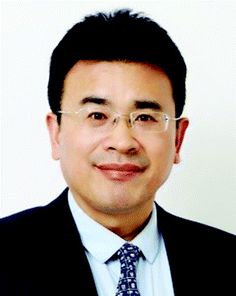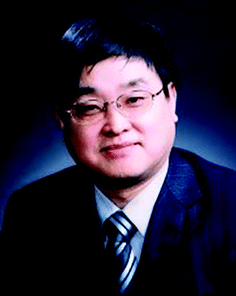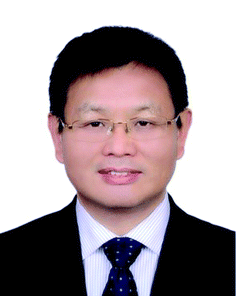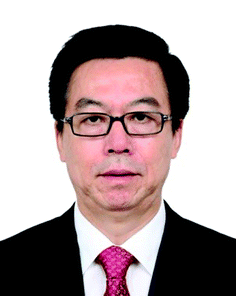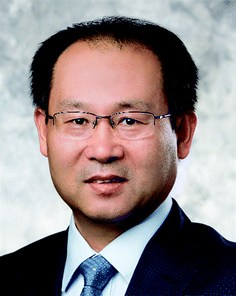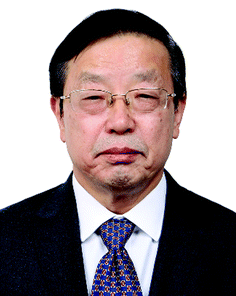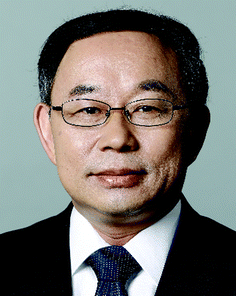Congratulations to the new academicians of the Chinese Academy of Sciences
The academician of the Chinese Academy of Sciences (CAS), as a lifelong honor, is the highest academic title of science and technology in People's Republic of China. At the end of 2017, nine famous Chinese chemists were elected as new members of CAS in the Chemistry Division. Congratulations to them!
Jun Chen (Nankai University) was born in September 1967 in Anhui Province, China. He obtained his BSc and MSc degrees from Nankai University in 1989 and 1992, respectively, and his PhD from Wollongong University (Australia) in 1999. He held the NEDO fellowship at National Institute of AIST Kansai Center (Japan) from 1999 to 2002. He became a full Professor of Nankai University in 2002. He is a Cheung Kong Scholar Professor, Director of Key Laboratory of Advanced Energy Materials Chemistry (KLAEMC) (Ministry of Education) and Dean of College of Chemistry at Nankai University, Chairman of the Chinese Society of Electrochemistry, and a Fellow of the Royal Society of Chemistry. He has published 290 SCI journal papers with citations exceeding 21![[thin space (1/6-em)]](https://www.rsc.org/images/entities/char_2009.gif) 000. With 10 edited books on energy chemistry and advanced batteries, he is also coinventor of 30 patents. Jun Chen is now the Associate Editor of Inorganic Chemistry Frontiers. His research focuses on advanced synthesis & preparation of nanostructured materials, which can be utilized in energy storage & conversion with batteries, fuel cells, and solar cells.
000. With 10 edited books on energy chemistry and advanced batteries, he is also coinventor of 30 patents. Jun Chen is now the Associate Editor of Inorganic Chemistry Frontiers. His research focuses on advanced synthesis & preparation of nanostructured materials, which can be utilized in energy storage & conversion with batteries, fuel cells, and solar cells.
Publication highlights
High K-storage performance based on the synergy of dipotassium terephthalate and ether-based electrolytes, Energy Environ. Sci., 2017, 10, 552–557, DOI: 10.1039/C6EE03185DUnconventional supercapacitors from nanocarbon-based electrode materials to device configurations, Chem. Soc. Rev., 2016, 45, 4340–4363, DOI: 10.1039/C6CS00041J
LiAlH4 supported on TiO2/hierarchically porous carbon nanocomposites with enhanced hydrogen storage properties, Inorg. Chem. Front., 2016, 3, 1536–1542, DOI: 10.1039/C6QI00200E
Zijian Guo (Nanjing University) was born in Hebei, China in 1961. He received his PhD degree from the University of Padova and worked as a postdoctoral research fellow at Birkbeck College, the University of London. He worked also as a research associate at the University of Edinburgh. He joined the School of Chemistry and Chemical Engineering at Nanjing University as a professor of chemistry in 1999, where he served as the director of the State Key Laboratory of Coordination Chemistry from 2000 to 2009 and the dean of the School of Chemistry and Chemical Engineering from 2006 to 2014. He is currently the Changjiang professor in the same school. He has co-authored ca. 150 publications since establishing his independent group. He was awarded the First Prize in Natural Sciences from the Ministry of Education of China in 2015, and won the Luigi Sacconi Medal from the Italian Chemical Society in 2016. Zijian Guo served as editorial/advisory board member of several national and international chemistry journals, including Dalton Transactions. His research interests include the design and application of fluorescent sensors for biological metals (such as zinc, copper and iron, etc.), the understanding of mechanism of action of platinum anticancer drugs and the development of anti-tumor active metal complexes with novel structural features.
Publication highlights
Dual aptamer modified dendrigraft poly-L-lysine nanoparticles for overcoming multi-drug resistance through mitochondrial targeting, J. Mater. Chem. B, 2017, 5, 972–979, DOI: 10.1039/C6TB02714HGlutathione boosting the cytotoxicity of a magnetic platinum(IV) nano-prodrug in tumor cells, Chem. Sci., 2016, 7, 2864–2869, DOI: 10.1039/C5SC04049C
Photoluminescence imaging of Zn2+ in living systems, Chem. Soc. Rev., 2015, 44, 4517–4546, DOI: 10.1039/C5CS00005J
Xiaojun Peng (Dalian University of Technology) received his PhD in 1990 at Dalian University of Technology. After completing postdoctoral research in Nankai University, he has been working at Dalian University of Technology since 1992. In 2001 and 2002, he has been a visiting scholar in Stockholm University and Northwestern University (USA), respectively. Currently, he is a professor and the director of State Key Laboratory of Fine Chemicals of China at Dalian University of Technology, and Academician of Chinese Academy of Sciences. He has been listed in “Highly Cited Researchers” by Thomson Reuters since 2015. His research interests cover photo-driven intelligent molecules and product engineering, including (1) fluorescent chemosensors for cations, anions, molecules, enzymes, proteins, DNA, RNA, reactive oxygen species, and for environmental factors such as temperature, polarity, viscosity, and pH; (2) photosensitizers for theranostics; and (3) chemical product engineering.
Publication highlights
A NIR fluorescent chemodosimeter for imaging endogenous hydrogen polysulfides via the CSE enzymatic pathway, J. Mater. Chem. B, 2017, 5, 2574–2579, DOI: 10.1039/C7TB00098GA NIR fluorescent probe: imaging endogenous hydrogen peroxide during an autophagy process induced by rapamycin, J. Mater. Chem. B, 2016, 4, 7363–7367, DOI: 10.1039/C6TB02463G
Fluorescent, MRI, and colorimetric chemical sensors for the first-row d-block metal ions, Chem. Soc. Rev., 2015, 44, 4337–4366, DOI: 10.1039/C4CS00285G
Zaiku Xie (Shanghai Research Institute of Petrochemical Technology) was born in Pulandian of Liaoning Province in September 1963. He graduated from Fushun Petroleum Institute in 1985 and received his PhD in 2000 from East China University of Science and Technology (ECUST). He jointed SINOPEC Shanghai Research Institute of Petrochemical Technology (SRIPT) in 1985. He was the director of National Engineering Research Center for Catalysts of Basic Organic Materials from 2002 to 2010, the chief scientist of National Basic Research Program of China (973 Project) from 2003 to 2013, and the president of SRIPT from 2003 to 2009. Now he is the director of the science and technology department of SINOPEC and the executive deputy director of the science and technology committee of SINOPEC. He is also a standing director of the Chemical Industry and Engineering Society of China from 2012, the vice president of the Catalysis Society of China from 2012, and the member of the Committee on Chemistry and Industry (COCI) of IUPAC from 2014. He is the author or co-author of more than 120 peer-reviewed scientific publications and 160 patents. He has won many important awards, such as the National Technology Invention Prize (for two times), Gold Medal of Chinese Patent, and Ho Leung Ho Lee Prize for Scientific and Technological Innovation by Ho Leung Ho Lee Foundation. He was elected as a fellow of the Royal Society of Chemistry in 2013. His research interests are in the field of fundamental and applied research in zeolite catalysis for industrial production of light olefins and aromatics.
Publication highlights
Computational insights into the reaction mechanism of methanol-to-olefins conversion in H-ZSM-5: Nature of hydrocarbon pool, Catal. Sci. Technol., 2016, 6, 3279–3288, DOI: 10.1039/C5CY01419KSimilarities and differences between aromatic-based and olefin-based cycles in H-SAPO-34 and H-SSZ-13 for methanol-to-olefins conversion: insights from energetic span model, Catal. Sci. Technol., 2015, 5, 4354–4364, DOI: 10.1039/C5CY00483G
Recent advances of pore system construction in zeolite-catalyzed chemical industry processes, Chem. Soc. Rev., 2015, 44, 8877–8903, DOI: 10.1039/C5CS00626K
Zuowei Xie (The Chinese University of Hong Kong) was born in January 1964. He obtained a BSc from Hangzhou University in 1983, an MSc from Shanghai Institute of Organic Chemistry (SIOC), the Chinese Academy of Sciences in 1986, and his PhD in 1990 from SIOC, working on a joint PhD program between SIOC and Technische Universität Berlin. After serving as a Research Associate in SIOC and a Postdoctoral Fellow at University of Southern California, he joined the chemistry faculty of The Chinese University of Hong Kong in 1995, was promoted to Professor in 2002, and Chair Professor in 2006. Since 2013 he has been the Choh-Ming Li Professor of Chemistry. He has co-authored over 270 papers and received several prestigious awards including the State Natural Science Prize in 2008, the Chinese Chemical Society Yao-Zeng Huang Award in Organometallic Chemistry in 2010, and The Croucher Award in 2003. He is a Fellow of the Royal Society of Chemistry and serves as advisory board member of Inorganic Chemistry Frontiers and Dalton Transactions. His research interests span a broad range of topics focusing on organometallic chemistry of carboranes, supercarboranes, metallacarboranes, carborynes, and metal-carborynes, synthesis and property of low-valent main group elements, and activation of small molecules.
Publication highlights
Dehydrogenative cross-coupling of: O-carborane with thiophenes via Ir-catalyzed regioselective cage B–H and C(sp2)–H activation, Chem. Commun., 2017, 53, 4818–4821, DOI: 10.1039/C7CC01485FPalladium catalyzed regioselective B–C(sp) coupling via direct cage B–H activation: synthesis of B(4)-alkynylated O-carboranes, Chem. Sci., 2016, 7, 5838–5845, DOI: 10.1039/C6SC00901H
Synthesis, structure, and alkyne insertion of a mixed-sandwich zirconacarborane alkyl, Inorg. Chem. Front., 2015, 2, 467–472, DOI: 10.1039/C4QI00244J
Wantai Yang (Beijing University of Chemical Technology) was born in October 1956 in Hebei Province. He received his Bachelor's degree from Tsinghua University in 1982 and MS degree in 1985 from Beijing University of Chemical Technology (BUCT) in China, respectively, and PhD degree from Royal Institute of Technology in Sweden in 1996. He started his research career in 1985 at BUCT, where he is currently a Professor of Polymer Chemistry and served as Dean (2005–2016) of College of Materials Sci. & Eng. He received China National Science Fund for Distinguished Young Scholar at 2000 and Chair Professor of Cheung Kong Scholars Programme at 2001. He has published more than 520 peer-reviewed papers in international journals and filed over 45 patents with more than 6500 citation and H index of 46. His research interest focuses on basic/fundamental chemistry for polymer synthesis and modification. At present, his main directions include photopolymerization, controlled/living polymerization, heterogeneous polymerization, new chemistry for surface modification of organic polymeric material.
Publication highlights
Combined chain- and step-growth dispersion polymerization toward PSt particles with soft, clickable patches, Polym. Chem., 2017, 8, 1404–1416, DOI: 10.1039/C6PY02094AVisible-light induced controlled radical polymerization of methacrylates with Cu(dap)2Cl as a photoredox catalyst, Polym. Chem., 2016, 7, 4226–4236, DOI: 10.1039/C6PY00687F
Synthesis of pH-responsive hydrogel thin films grafted on PCL substrates for protein delivery, J. Mater. Chem. B, 2015, 3, 7673–7681, DOI: 10.1039/C5TB01149C
Jian-Min Yue (Shanghai Institute of Materia Medica) was born in May 1962. He received his BSc degree in Chemistry in 1984 from Lanzhou University, where he completed his PhD degree in Natural Products Chemistry in 1990 under the guidance of the late Professor Yao-Zu Chen. He was a postdoctoral fellow (1991–1993) in the Department of Phytochemistry, Kunming Institute of Botany, Chinese Academy of Sciences, hosted by Professor Han-Dong Sun. He was a postdoctoral fellow (1993–1994) in the School of Chemistry, University of Bristol, hosted by Professor Geoffrey Eglinton in Geoorganic Chemistry. Then he returned to Kunming Institute of Botany and worked as Associate Professor (1994–1996). He joined the staff of the Joint Laboratory of Unilever Research and Shanghai Institute of Organic Chemistry, Chinese Academy of Sciences, as a Senior Research Scientist (1996–1999) on Natural Products Chemistry. He then moved to Shanghai Institute of Materia Medica, where he remains to date. He has authored and co-authored over 270 papers and book chapters, and been the recipient of numerous honors and awards including National Natural Science Prize (2013, 2nd Class, People's Republic of China), Municipal Natural Science Prize (2010, 1st Class, Shanghai Municipal Government), and Wu Jieping-Paul Janssen Medical & Pharmaceutical Award (2016). His research interests include the isolation, structure determination, and synthesis of bioactive natural products, particularly focusing on natural products with activity against infectious and immuno-related diseases, cancer and neurodegenerative disorders.
Publication highlights
Antimalarial diterpenoid dimers of a new carbon skeleton from Aphanamixis grandifolia, Org. Biomol. Chem., 2016, 14, 957–962, DOI: 10.1039/C5OB02296GRecent studies on the chemical constituents of Trigonostemon plants, Org. Chem. Front., 2014, 1, 1225–1252, DOI: 10.1039/C4QO00161C
Dammarane-type triterpenoids as 11β-HSD1 inhibitors from Homonoia riparia, Org. Biomol. Chem., 2014, 12, 4716–4722, DOI: 10.1039/C4OB00807C
Dong Hui Zhang (Dalian Institute of Chemical Physics) was born in January 1967 in Zhejiang. He received his BS degree in physics from Fudan University in 1989, and earned a PhD in chemical physics from New York University in 1994. After working as a postdoctoral research fellow in New York University and the University of Chicago, he joined the National University of Singapore in 1997. He moved to Dalian Institute of Chemical Physics, CAS, in 2006. Now he is the director of the state key laboratory of molecular reaction dynamics in the institute. He won National Science Award of Singapore in 2003 and the Second Class National Science Award of China in 2014. His primary research area is in theoretical and computational studies of chemical reactions in the gas phase and on surfaces. He expanded the scope of accurate theoretical study of chemical reaction dynamics from triatomic to polyatomic reactions by developing the time-dependent wave packet methods for polyatomic reactions in combination with accurate potential energy surface constructions.
Publication highlights
Recent advances in quantum scattering calculations on polyatomic bimolecular reactions, Chem. Soc. Rev., 2017, 46, 7625–7649, DOI: 10.1039/C7CS00526AA seven-dimensional quantum dynamics study of the dissociative chemisorption of H2O on Cu(111): effects of azimuthal angles and azimuthal angle-averaging, Chem. Sci., 2016, 7, 1840–1845, DOI: 10.1039/C5SC03689E
A local mode picture for H atom reaction with vibrationally excited H2O: a full dimensional state-to-state quantum dynamics investigation, Chem. Sci., 2016, 7, 261–265, DOI: 10.1039/C5SC03472H
Yuliang Zhao (National Center for Nanosciences and Technology of China) was born in February 1963. He received his BS degree from Sichuan University in 1985, and MS and PhD from Tokyo Metropolitan University in 1996 and 1999, respectively, under the guidance of Professor Hiromichi Nakahara. After working as Japan JSPS Fellow in Tokyo Metropolitan Univ. & RIKEN (The Institute of Physical and Chemical Research) for two years, he joined Institute of High Energy Physics, Chinese Academy of Sciences in 2001, and served as executive dean in College of Chemistry, Graduate University of Chinese Academy of Sciences (2005–2008). From 2008, he is the director of CAS Key Lab for Biomedical Effects of Nanomaterials & Nanosafety. Since 2011, he is Deputy Director-General, Professor, National Center for Nanosciences and Technology of China. He has published ∼400 peer-reviewed scientific papers, 8 editorials in international journals, with >22![[thin space (1/6-em)]](https://www.rsc.org/images/entities/char_2009.gif) 000 citations, and has edited and published 13 books. He has received several prestigious awards including TWAS Prize in Chemistry (2016), National Prize for Natural Sciences (Second Class, 2012), the National Natural Science Fund for Distinguished Young Scholars (2005), the Chinese Academy of Sciences-Bayer Young Scientist Award (2006). Yuliang Zhao serves in the advisory board of Nanoscale Horizons. His research interests include biological effects/activities of nanomaterials with an emphasis on the establishment of reliable and valid analysis methods for the testing of nanomaterials and nanomedicines in biological systems and understanding of the chemical mechanisms of nanosafety issues.
000 citations, and has edited and published 13 books. He has received several prestigious awards including TWAS Prize in Chemistry (2016), National Prize for Natural Sciences (Second Class, 2012), the National Natural Science Fund for Distinguished Young Scholars (2005), the Chinese Academy of Sciences-Bayer Young Scientist Award (2006). Yuliang Zhao serves in the advisory board of Nanoscale Horizons. His research interests include biological effects/activities of nanomaterials with an emphasis on the establishment of reliable and valid analysis methods for the testing of nanomaterials and nanomedicines in biological systems and understanding of the chemical mechanisms of nanosafety issues.
Publication highlights
Biodistribution, excretion, and toxicity of polyethyleneimine modified NaYF4:Yb,Er upconversion nanoparticles in mice via different administration routes, Nanoscale, 2017, 9, 4497–4507, DOI: 10.1039/C7NR00078BA highly sensitive SERS-based platform for Zn(II) detection in cellular media, Chem. Commun., 2017, 53, 1797–1800, DOI: 10.1039/C6CC08541E
Silica-coated bismuth sulfide nanorods as multimodal contrast agents for a non-invasive visualization of the gastrointestinal tract, Nanoscale, 2015, 7, 12581–12591, DOI: 10.1039/C5NR03068D
Ben Zhong Tang
Editor in Chief, Materials Chemistry Frontiers
Zhen Li
Member of Materials Chemistry Frontiers Editorial Board
| This journal is © the Partner Organisations 2018 |

